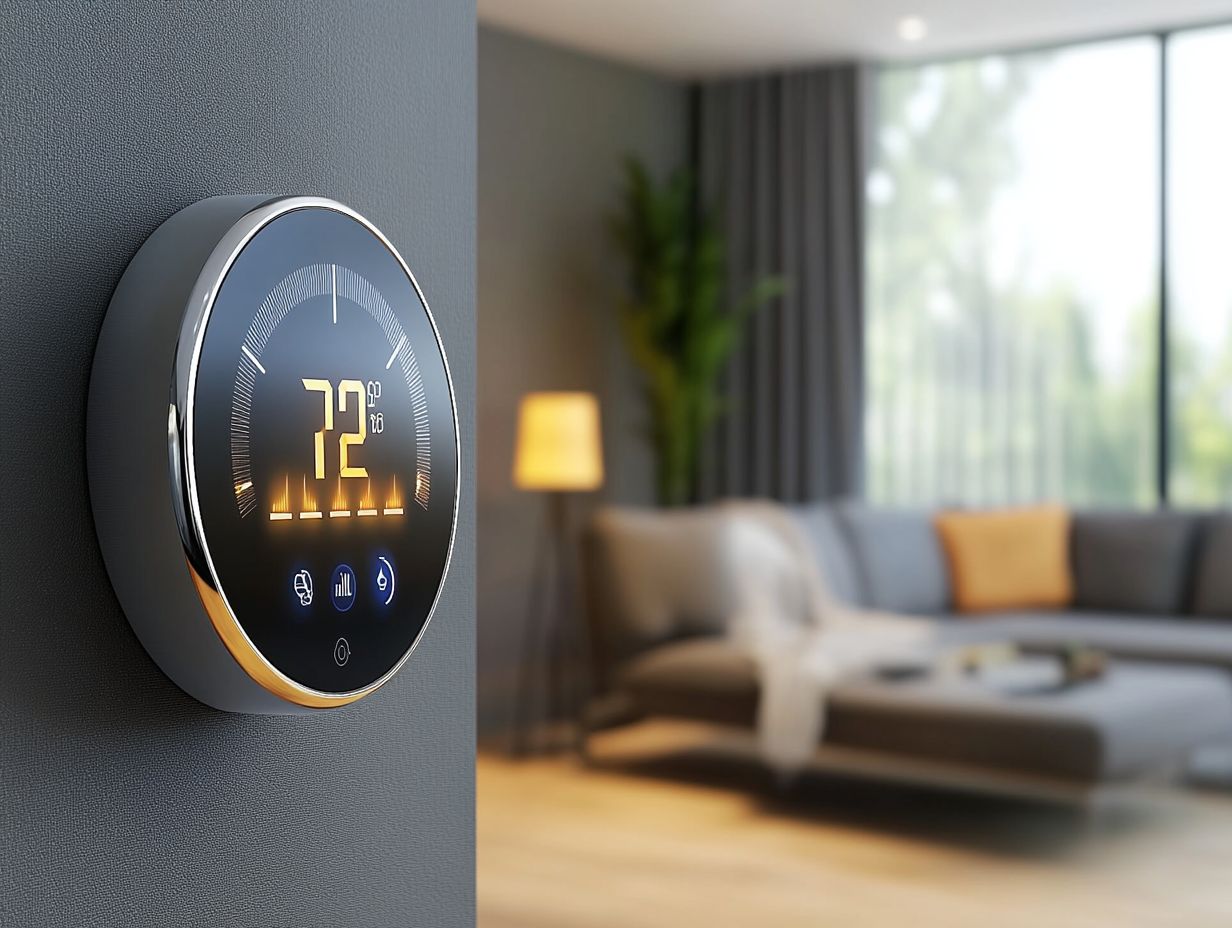Smart thermostats, a key component of home automation, are transforming the way we manage our home environments, seamlessly integrating technology with comfort to create more efficient living spaces.
This article delves into what smart thermostats are, highlighting their defining features and how they leverage sensors and Wi-Fi connectivity to optimize heating and cooling through advanced features like temperature control.
You will discover the various benefits they provide, including energy savings and intelligent learning, along with tips for selecting the ideal model that suits your lifestyle. It also addresses the question of whether to handle installation on your own or hire a professional for cost savings.
Additionally, we will share programming and maintenance tips, such as eco mode and humidity control, to help you maximize the effectiveness of your smart thermostat.
Prepare to take control of your home's comfort like never before with innovative features that enhance home comfort and energy efficiency!
What are Smart Thermostats?

Smart thermostats are sophisticated devices designed to enhance home comfort by automatically adjusting heating and cooling settings according to user preferences. These digital thermostats work seamlessly with smart home technology, offering features such as programmable settings, remote access, voice control, and energy reports.
These capabilities not only improve energy efficiency but also help reduce energy bills.
Definition and Features
Smart thermostats come equipped with various features, such as programmable settings, energy efficiency ratings, and learning algorithms that enable them to adapt to user preferences effectively.
Moreover, many of these devices offer Wi-Fi connectivity, which allows users to control their home’s temperature remotely via smartphones or tablets. This functionality provides an exceptional level of convenience, as adjustments can be made from virtually anywhere using a mobile app.
The user interface is generally designed to be intuitive and user-friendly, making it accessible even for those who may not be particularly tech-savvy. Advanced sensor technology is also employed to monitor occupancy and temperature variance, adjusting heating or cooling as needed to conserve energy when spaces are unoccupied.
These innovative features not only enhance the overall user experience but also contribute to significant energy savings and smart energy use, transforming homes into smarter and more sustainable environments.
How do Smart Thermostats Work?
Smart thermostats utilize advanced sensors and connectivity options that enable them to effectively monitor and control indoor temperature. These devices connect to HVAC systems via Wi-Fi, allowing for remote temperature monitoring and remote temperature management, and the ability to make adjustments based on real-time data and user settings.
Sensors and Connectivity
The effectiveness of smart thermostats is significantly influenced by the quality of the sensor technology and network connectivity, including cloud connectivity, integrated within the devices.
These components collaborate to monitor and manage indoor climates with impressive accuracy. Temperature sensors collect real-time data on ambient conditions, ensuring that the system responds swiftly to any changes. This data is transmitted through a reliable network connection, enabling immediate adjustments to the heating and cooling systems.
Remote access is particularly important, as it allows users to manage their climate settings from virtually anywhere via mobile applications, enhancing app functionality.
With just a few taps on their smartphones, individuals can modify settings, receive alerts, and even analyze usage patterns, all of which contribute to a more energy-efficient and comfortable living environment.
Benefits of Using a Smart Thermostat
The advantages of utilizing a smart thermostat are quite noteworthy, particularly in terms of energy savings, smart home integration, and increased convenience for homeowners.
These devices optimize temperature control through predictive algorithms and user alerts, which can lead to reduced energy consumption. Additionally, they enhance the overall user experience when it comes to managing the home's climate.
Energy Savings and Convenience
One of the primary advantages of smart thermostats is their capacity to deliver energy savings while simultaneously enhancing user convenience.
These devices utilize predictive algorithms to analyze user habits and preferences, enabling them to make automatic adjustments that optimize temperature settings throughout the day. For example, when occupants typically leave home in the morning, the thermostat can lower the heating or cooling, leading to significant energy savings—some users report reductions of up to 30% on their utility bills.
One homeowner recounted that after installing a smart thermostat, their monthly energy costs decreased significantly, demonstrating that both comfort and financial benefits can be easily obtained.
Additionally, many of these devices offer insights and actionable recommendations based on historical data, making them invaluable for anyone seeking to save money while enjoying a comfortable living environment.
Choosing the Right Smart Thermostat for Your Home
Selecting the right smart thermostat for your home requires a clear understanding of how it will work with your existing HVAC systems and system compatibility, as well as taking into account your personal preferences and thermostat trends.
Well-known brands provide a range of models designed for various smart home applications, including Alexa compatibility and Google Home integration, so it's important to evaluate the features that align with your lifestyle.
Factors to Consider and Popular Brands
When selecting a smart thermostat, it is important to consider factors such as compatibility with your HVAC system, including residential heating systems, and the features offered by various reputable brands.
These features can greatly enhance the overall user experience, offering benefits like energy reports and energy monitoring that help monitor usage patterns and identify potential savings opportunities. Smart sensors play a vital role in optimizing climate control by detecting occupancy and adjusting temperatures accordingly. Many devices also connect with mobile applications, enabling users to manage settings remotely and receive alerts about significant changes.
For example, Nest is often praised for its intuitive learning capabilities, while Ecobee stands out with its additional room sensors. User feedback consistently highlights these strengths, making it easier for individuals to choose a thermostat that aligns with their specific needs.
Installation and Setup of a Smart Thermostat
Installing a smart thermostat can be quite simple, and you have the choice between a DIY setup or hiring professionals for the installation.
A comprehensive installation guide usually provides clear steps to effectively connect the device to your HVAC system, as well as to ensure that you can control it remotely through mobile app integration.
DIY vs Professional Installation
When considering the installation of a smart thermostat, homeowners have the option of either a DIY approach or hiring a professional, each presenting its own advantages.
The decision between these two methods often hinges on personal preferences, levels of expertise, and budget considerations. A DIY installation can be particularly appealing for those who enjoy hands-on projects, as it not only saves on labor costs but also provides a valuable opportunity to gain a deeper understanding of their home’s heating and cooling systems. On the other hand, opting for a professional installation guarantees precision and often includes warranties for any future services, enhancing home improvement and smart heating solutions.
Regardless of the chosen method, it is essential to prioritize safety. This includes shutting off the power before commencing work and using the proper tools. For those who prefer the DIY route, adhering to a comprehensive step-by-step installation guide can significantly reduce the likelihood of errors, ensuring system compatibility and user empowerment.
Such a guide typically covers key aspects such as:
- Verifying compatibility with existing systems, ensuring compatibility with automation rules and smart grid setups,
- Gathering the necessary tools,
- Carefully following wiring diagrams to ensure a seamless setup.
Tips for Maximizing the Use of Your Smart Thermostat
To make the most of your smart thermostat, it's important to take advantage of its programming features, such as programmable schedules and seasonal adjustments, and maintenance tips for optimal performance.
By scheduling temperatures to align with your family's routines, you can improve home comfort, using features like adaptive algorithms and intelligent learning, while also receiving valuable insights for energy optimization.
Programming and Maintenance Tips
Programming a smart thermostat effectively and staying updated on maintenance tips, including maintenance reminders, can lead to notable energy optimization and improvements in comfort.
By investing time in understanding temperature scheduling and seasonal settings, users can customize their home environments to better suit their personal preferences and daily routines. Features like setting lower temperatures at night, using dual-zone heating, or adjusting the thermostat based on home occupancy can help conserve energy while enhancing overall comfort.
Regular maintenance tasks, such as checking the cleanliness of filters and ensuring sensors are functioning correctly, are also vital for maximizing efficiency and improving indoor climate. Additionally, monitoring usage patterns allows for timely adjustments, ensuring the system adapts effectively to changing conditions throughout the year, supporting smart energy solutions and building automation.




